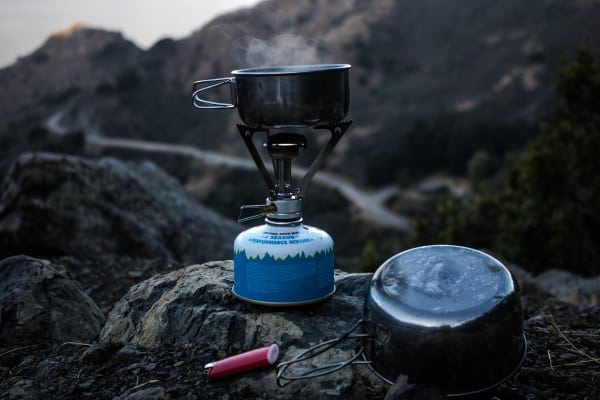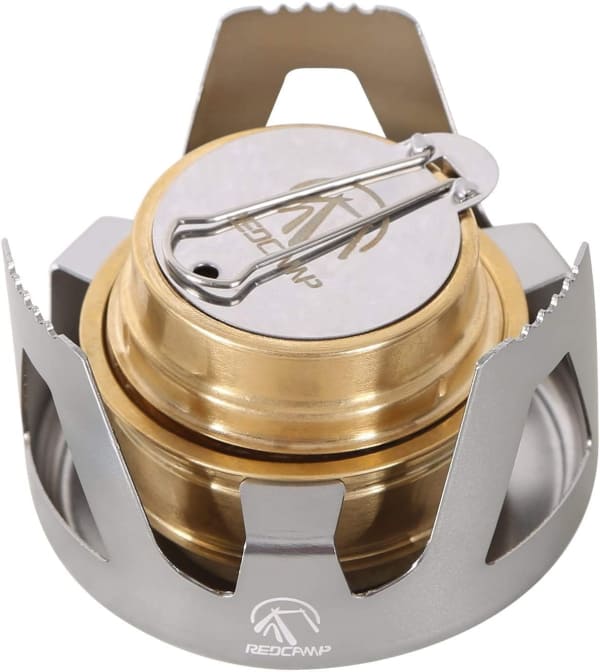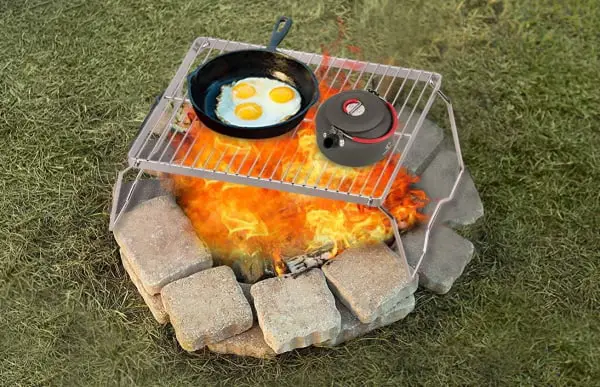
A camping stove can make cooking easy both at the campsite and on the trail. But people didn’t always use camping stoves and not everyone uses them now.
So, do you really need a camping stove? A camping stove is often the only legal way to cook food over a fire during campfire bans. In many areas of the west, campfires are permanently banned so it’s even more important to have a camping stove when camping in western states.
Even so, not all camping stoves are legal to use during campfire bans and in some cases, all forms of fire may be banned in the area you’re camping, hiking, or backpacking through.
Let’s take a deeper look at the different kinds of camping stoves you might want to consider.
Table of Contents
Propane Camping Stoves
Propane camping stoves are easy to find and they’re easy to refuel. These camp stoves offer a consistent flame that you have full control over. As a result, you’ll usually be able to use them even in the dry season.
Another advantage with propane is the fact that it burns well in colder temperatures. Studies show that propane will still vaporize even at temperatures of -43 degrees Fahrenheit. This makes it a great fuel for winter camping.
The major downside to this type of camping stove is that it’s big. Also, it burns quickly so you’ll burn through propane faster than you would burn through a butane stove.
I think propane camping stoves are fantastic for car campers and for campers who are operating out of a stationary base camp.
Butane Camping Stoves
Butane camping stoves are a less expensive alternative to propane camping stoves. They run on small cans of butane that you can buy in bulk.
These camping stoves are fine for general camping but they won’t do well in temperatures below freezing. For this reason, many small backpacking stoves will be designed to run on mixtures of both butane and propane. These mixtures will often be labeled as “four-season mixtures”.
If you need a car camping stove or an emergency stove for your house, butane is a great way to go. Serious thru-hikers or backpackers moving through cold areas will be better off with a small camp stove and a propane/butane mixture.
Propane/Butane Mixtures
As I mentioned in the last section, you can buy canisters of propane/butane mixtures for backpacking stoves. The picture at the top of this post is a good example of this kind of stove.
The great advantage of these types of stoves and mixtures is the fact that they’re reliable and easy to use out on the trail. The backpacking stove will pack down small and won’t weigh much.
On the other hand, the canister is still going to take up room in your backpack and you’ll have to pack this canister out with you even after it no longer has any fuel in it.
Another disadvantage of this type of fuel is that it can often be hard to tell how much fuel is left. You may have to do some experimentation with different fuels at different temperatures and altitudes before you can properly gauge how much fuel you’ll need to bring with you on your trip.
The cost of this setup is both a positive and a negative. You’ll find the stoves don’t cost much, but the fuel canisters do. On top of this, you’ll have to make sure you properly recycle the can when you’re done.
White Gas Stoves
White gas stoves are interesting because they take a liquid fuel and turn it into a gas for you to cook with. These stoves are versatile and will often take a wide variety of liquid fuels. As a result, they make great backpacking and emergency stoves.
A white gas stove will also work better at lower temperatures. This makes it great for people who will be camping in the winter or backpacking at high altitudes.
The downside to this stove is that you have to deal with carrying around a liquid fuel. Also, this type of stove needs to be primed and this can add to the amount of time it takes to cook food or boil water.
Alcohol Camping Stoves
Alcohol camping stoves are generally only used for boiling water. They take a bit longer to boil water and you’ll generally only find them in backpacking models so don’t plan on cooking up a big feast at your car camping site with one of these stoves.
On the plus side, they run on inexpensive and clean-burning denatured alcohol and they don’t cost much. In fact, a lot of people make their own using cans of tuna or cat food.

If you don’t want to have to make your own alcohol camping stove, you can always buy a fancy looking alcohol stove like the one you see above. Even so, you’ll still probably end up spending less than $20.00 on it.
Wood Camping Stoves
Wood camping stoves come in many different forms. You can buy a cheap backpacking stove that folds up or you can buy an expensive rocket stove or BioLite stove.
The main problem with all of these stoves is the fact that they can’t simply be turned off at the push of a button. This means that you may not be able to use them while backpacking through certain areas and you won’t be able to use them while camping during a fire advisory.
This being said, there are some big benefits to cooking with wood camping stoves. The primary one being the fact that you’ll never have to pay for fuel again. On top of this, you’ll have a great emergency stove that you can use at home during power outages.
Fuel Cube Stoves
A fuel cube camping stove is a stove that runs on small fuel tablets. These cubes light up easily and burn efficiently. On top of this, they can easily be extinguished and reused again.
I like these stoves for backpacking because they don’t take up much space and you don’t have to really do any maintenance on them.
On the other hand, I wouldn’t recommend them for car camping or for large base camps. These stoves are too small and inefficient to cook meals on so they’re mostly used for boiling water and heating up pre-cooked food.
Also, these stoves may not be legal during fire advisory warnings.
Electric Camping Stoves
An electric camping stove is a great idea for car campers with access to electricity. Hot plates, electric grills, and induction burners can provide you with a quick and easy method for making large meals and you won’t have to worry about bringing fuel with you.
These camp stoves don’t pose the same fire risks as stoves with open flames and you can take away any fire threats they may pose simply by unplugging them.
The major downside to an electric camping stove is that you’ll have to choose a campsite with electricity.
Flameless Heaters
Flameless heaters, also known as chemical heaters, heat up and sometimes even cook food using chemicals that are activated with water. The term chemical might conjure up bad images, but these chemicals generally just consist of food-grade iron, magnesium, and salt.
I love the fact that you can cook with these heaters in all sorts of weather and you never have to worry about working with an open flame. They can safely be used indoors and at the time of this writing, it’s perfectly legal to put these in your carry-on baggage when traveling. Try to do this with propane or liquid gas and you’ll probably end up having a really bad day.
Where to Find Flameless Heaters
You’ll find flameless heaters in MREs and other dehydrated meal packages but these aren’t the only places to get them. Companies like Barocook have created flameless cookware that you can use to cook full meals.
Cooking Over A Fire
Cooking over a fire can be a lot of fun and there are a lot of ways to do it. Again, you will have to check to make sure that it’s permissible to have a fire in the area you’re in before you get there or you may end up going hungry.
One of the easiest and cheapest ways to cook over a fire is to pop your meat or vegetables onto a stick that you then hold over the fire. I wouldn’t recommend doing this with large pieces of uncooked meat but it’s perfect for things like hot dogs and shish kabobs.
The next easiest way to cook over a fire is to buy a campfire grill. You can buy food-grade stainless steel grates to cook directly on or you can buy a grate that’s large enough to hold your pots and pans.

Click here to buy the stainless steel campfire grill above.
People Also Ask
How much camping stove fuel do I need?
The amount of fuel you will need will vary dramatically based on what type of fuel you’re using, where you’re using it, and what you intend to cook with it. Checking with your stove’s manufacturer can help you plan but at the end of the day, you’ll probably need to run some tests on your own.
Can you use a stove in a tent?
There are stoves that you can use to heat up and to cook in your tent. These stoves must be used with a tent that’s designed to work with a tent stove.
Alternatively, use flameless heater cookware inside your tent.
Summing It All Up
If you want a hot meal while camping, consider bringing a camping stove with you.
